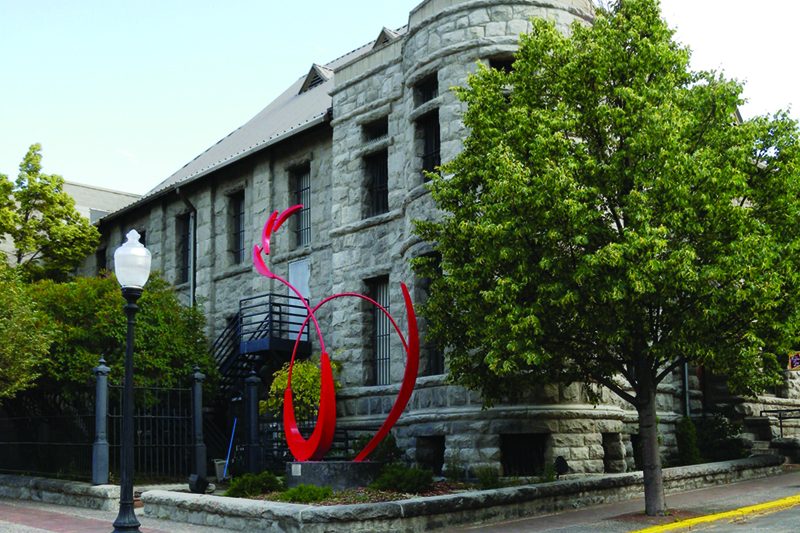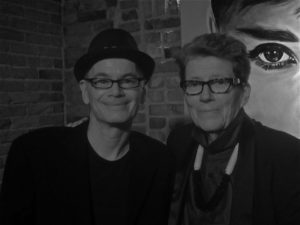
Myrna Loy Center with Richard Swanson's sculpture
From jailhouse to art house
The Myrna Loy Center celebrates its history and legacy with a festival, street party and concert July 30. Party with founding director Arnie Malina, along with some of the Footsoldiers of Art who helped transform the Myrna Loy from jailhouse to art house.
Story booths, photo archives, movie events, live music, food, libations, and – most likely – juggling are among the offerings at the free birthday party.

Festivities culminate in a concert at 7:30 p.m., “Life in the Key of Alex,” celebrating the music and contributions of Helena-born pianist and composer Alex Swaney, one of the creative conspirators behind Second Story Cinema, the scrappy little film house that became the Myrna Loy. She also helped start two well-known Montana bands – Cheap Cologne and The Jane Finnigan Quintet – and was Folklife director for the Montana Arts Council for several years.
“She’s been there the whole time,” says the center’s executive director, Krys Holmes. “So quiet and unassuming. It’s a perfect opportunity to celebrate her gifts.”
Swaney composed a number of jazz-based pieces that Bob Packwood and MJ Williams will bring to life – some of them for the first time on the Myrna Loy stage. Admission is $25, and proceeds help sustain the center’s 40-year-old independent film program.
Call 443-0287 or visit www.myrnaloycenter.com for details.
The Myrna’s comeback story
Nearly two years ago, Helena’s beloved Myrna Loy Center was on the edge of collapse. Now, it’s celebrating 25 years in the renovated county jail, and a history that goes back 40 years, to the inception of Second Story Cinema.
It’s a comeback story that executive director Krys Holmes credits to the community. “Helena is so amazing that way,” she says. “They were determined not to let the Myrna go down.”
The center, which screens foreign and independent films and offers some of the most vibrant performing arts programming in Montana, was spawned in 1976. Its founder, Arnie Malina, along with Alex Swaney and Jay Tieger, headed to Missoula to catch a film at the Crystal Theater. On the way back, the trio began to wonder why they had to drive more than 100 miles to see a classic or foreign film.
That roadtrip and subsequent conversations were the genesis of Second Story Cinema, founded by Malina and Tieger upstairs in the old Placer Building. Almost immediately, they began to bring in performers too, and provide a venue for local cultural events.
A grant from the National Endowment for the Arts in 1985 helped the organization move into its current home in the historic Lewis and Clark County Jail, which was renamed in honor of film star and Montana native Myrna Loy.
As founding director of the Myrna Loy Center, Malina won the Fannie Taylor Career Achievement Award from the Association of Performing Arts Presenters in 1994. In 1997, the center received the Governor’s Arts Award and was lauded as “essential to the cultural life of Montana.” It was the same year that Malina moved to Vermont and became artistic director of the Flynn Center in Burlington (he retired in 2011).
Ed Noonan took over as director in 2000 – stepping in at a time when the center had closed temporarily, due to red ink. Both men were members of the National Performance Network (NPN), and Noonan still serves on that board. It’s an organization that shares their vision of “fostering diversity and artistic experimentation through support for artists and cultural organizers.”
Myrna goes to graduate school
Over the years, that national connection helped the Myrna offer wide-ranging and often eccentric performances of a nature rarely, if ever, seen in Montana. Among the more innovative: Project Bandaloop’s “Portal,” performed on a Missouri River bridge; a dance/jazz/Native American work by Garth Fagan Dance, pianist Don Pullen and the Chief Cliff Singers, which toured around the country, including performances in New York City and the Flathead Indian Reservation; and “Geyser Land,” by Mary Ellen Strom and Ann Carlson, which was observed by audiences from railroad cars traveling along the tracks between Livingston and Bozeman.
The Myrna Loy’s long participation in NPN also put it in the running for a multi-million dollar effort to build financial and organizational strength in the arts, supported in part by the Andrew W. Mellon Foundation. The center was one of six arts organizations nationwide chosen for the program, called Leveraging a Network for Equity.
“It’s like sending your arts center to graduate school,” says Holmes. The four-year program includes clinics, workshops, individual financial consulting and investment capital.
“What a powerful legacy we have”
Holmes, who became interim director in 2014 and executive director in 2015, echoes the values of her predecessors. “Arnie’s legacy, his vision, was for the Myrna to be a place to share film and live performances that give voice to perspectives outside the mainstream.”
Noonan, she adds, “gave so much of his heart and soul to the Myrna, holding it to its mission even when it was tremendously difficult to do.”
Between Malina’s vision, and Noonan’s steadfast advocacy for individual artists, “what a powerful legacy we have.”
Holmes came to leadership at the Myrna gradually, having served as a volunteer, staff member, board member and patron. “I have a pretty deep understanding of what the Myrna is at its core,” she says.
“As we go forward and change, I hope to remain steadfast to the unique identity of the Myrna … and be able to not just hang in there and keep the doors open, but to break new ground.”
– Kristi Niemeyer